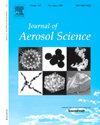A direct and theoretically consistent method for the calculation of the settling speed of prolate spheroidal particles in the atmosphere
IF 2.9
3区 环境科学与生态学
Q2 ENGINEERING, CHEMICAL
引用次数: 0
Abstract
We propose a new method for calculating the settling speed of aerosol particles with prolate shape in the atmosphere. This method takes into account the known theoretical results on the speed–force relationships for prolate spheroids moving in a fluid, and the results in Mallios et al. (2021) regarding the orientation of prolate particles settling in the atmosphere. Unlike other studies, we focus not on the resistance problem (calculating the aerodynamic force as a function of speed) but on the mobility problem (calculate terminal velocity as a function of the external force). The result of this approach is a set of equations that permit to directly calculate the settling speed of a prolate particle in the atmosphere as a function of its shape and characteristics, which is a very important quantity in atmospheric science since the settling speed of a falling particle is a key factor to determine its lifetime in the atmosphere. With this approach, we show that the settling speed is reduced by up to 20% for particles with aspect ratio 4 compared to same-volume spheres. We compare the results of the present study to CFD results of Sanjeevi et al. (2022) and to laboratory measurements of Bhowmick et al. (2024), the latter comparison showing that the estimates for settling speed from our method is within compared to the measured value. Finally, since calculating the terminal speed of settling particles is an important issue in atmospheric modeling, we provide a Fortran module implementing the method described in the present study.

一种计算长球状粒子在大气中沉降速度的直接和理论上一致的方法
提出了一种计算长形气溶胶粒子在大气中沉降速度的新方法。该方法考虑了关于在流体中运动的长形球体的速度-力关系的已知理论结果,以及Mallios等人(2021)关于在大气中沉降的长形颗粒方向的结果。与其他研究不同,我们关注的不是阻力问题(计算作为速度函数的气动力),而是机动性问题(计算作为外力函数的终端速度)。这种方法的结果是一组方程,可以直接计算出一个长波粒子在大气中的沉降速度作为其形状和特性的函数,这是大气科学中一个非常重要的量,因为下落粒子的沉降速度是决定其在大气中寿命的关键因素。通过这种方法,我们发现与相同体积的球体相比,长径比为4的颗粒的沉降速度降低了20%。我们将本研究的结果与Sanjeevi et al.(2022)的CFD结果以及Bhowmick et al.(2024)的实验室测量结果进行了比较,后者的比较表明,我们的方法估计的沉降速度与实测值相比在±5%以内。最后,由于计算沉降粒子的终端速度是大气模拟中的一个重要问题,我们提供了一个Fortran模块来实现本研究中描述的方法。
本文章由计算机程序翻译,如有差异,请以英文原文为准。
求助全文
约1分钟内获得全文
求助全文
来源期刊

Journal of Aerosol Science
环境科学-工程:化工
CiteScore
8.80
自引率
8.90%
发文量
127
审稿时长
35 days
期刊介绍:
Founded in 1970, the Journal of Aerosol Science considers itself the prime vehicle for the publication of original work as well as reviews related to fundamental and applied aerosol research, as well as aerosol instrumentation. Its content is directed at scientists working in engineering disciplines, as well as physics, chemistry, and environmental sciences.
The editors welcome submissions of papers describing recent experimental, numerical, and theoretical research related to the following topics:
1. Fundamental Aerosol Science.
2. Applied Aerosol Science.
3. Instrumentation & Measurement Methods.
 求助内容:
求助内容: 应助结果提醒方式:
应助结果提醒方式:


